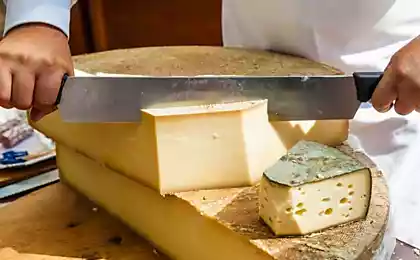1075
Swiss scientists have refuted the theory about the cause of the appearance of holes in the cheese

The mice in no way to blame i>
The epigraph - Say,
Who spoiled cheese?
Who is it done
So many holes?
- Anyway,
Not me! - Hastily grunted
Pig.
- Mysteriously! - Gus exclaimed. - A-ha guess
I am not going!
Snake said, almost in tears:
- Be-e-reasonable to a difficult task!
All is not clear, all vaguely - Ask better
At the bar!
- All the evil - from cats! - I said,
Having sniffed the cheese,
Yard dog. - As twice two is four,
From them, and holes in the cheese!
A cat with an angry snort roof:
- Who wears away the hole?
Clear - click!
But then God brought Crow.
- Hurray!
It will solve the problem.
As is known,
She
Cheese
The special flair!
And entrusted
Raven
Check deal
Comprehensively ...
In his haste to solve the mystery of holes,
Crow
Deepened
In the cheese.
Here
Holes
Shire,
wider,
wider ...
Where is the cheese?
Forget about cheese!
Wailed the whole barnyard:
- Robbery! Robbery! Razor! Shame!
Soared fence
Crow
And said
Injured:
- Well, that's, you know, nitpicking!
You
Interested
Holes?
So what's the deal?
I ate cheese,
A hole - Everything! - Remained intact!
This was over a dispute,
And that is why
Until now,
Alas,
Nobody knows
In the world,
Where did all the
The holes in the cheese!
Boris Zakhoder, "Holes in cheese»
Who in childhood was not interested in the origin of the holes in the cheese ? Wikipedia claims that they - the result of isolated bacteria Propionibacter shermani carbon dioxide that accumulates in the form of bubbles. This was known from the study of the American scientist William Clark, who published their work on this subject as early as 1917.
But швейцарские Scientists refute is a long established opinion. Pron curiosity from childhood to adulthood, the researchers from the Swiss government agricultural research center Agroscope argue that the presence of the hole - the result of the presence of microscopic pieces of hay in the original milk. The work was done in collaboration with government laboratories Applied Sciences and Technologies of Switzerland.
It turned out that the use of modern methods of milking pails and sealed sterile milk cheese holes disappear. Over the past 15 years, the holes in Swiss cheese gradually disappeared as more farmers began to move on the modern equipment.

The modern equipment on farms i>
The researchers made this conclusion on the basis of periodic observations of ripening cheese using компьютерной tomography . Observations were within 130 days.
Cheese - one of the oldest foods. Historians argue where the first born cheese. The oldest finds date back to 5500 BC and they have been found in present-day Poland. In Russia until Peter I the cheese produced "natural raw" manner - ie without heat treatment. So he called cheese. Under Peter I appeared in Russia, European cheeses.
Source: geektimes.ru/post/251674/























